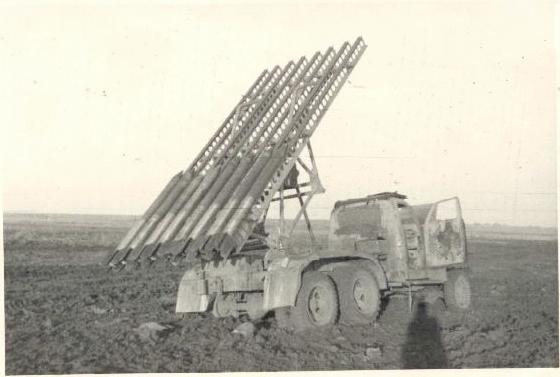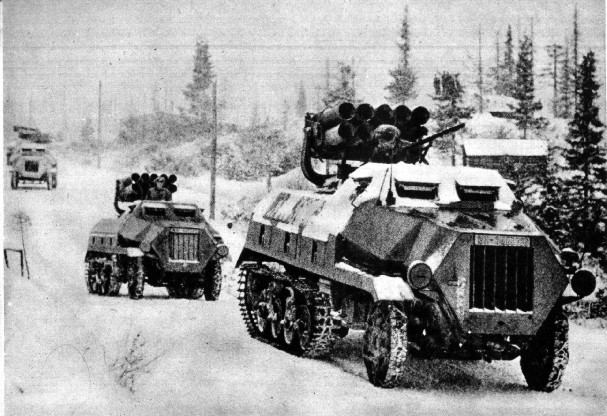

Based on experience with mounting 105 mm howitzers on half-tracks the US Army wanted a fully tracked version. Used a modified M3 Medium or M4 Medium tank chassis. Upper hull was modified to hold a 105 mm howitzer in the front. A drum-like cupola was added on the right side to hold a .50 cal MG. Two prototypes were built and designated T32. Had an open superstructure with a M1A2 105 mm howitzer installed to the right of the center. It was accepted and standardized as the M7 HMC in February 1942. Was declared Substitute Standard in January 1945. Production models had modified shields and a cupola for the AA MG. 105 mm had velocity of 1,550 ft/sec, and range of 12,205 yards. The MG compartment looked like a pulpit and was nicknamed "The Priest" by the British.
Dimensions: 6.19 x 2.54 x 2.87 (h) mt
Weight: 22.6 tons
Armor (max): 62 mm
Speed (max): 40 km/hr
Engine: Ford GAA 450 hp
Armament: 1x 105mm M2A1 L/22.5 cannon
Crew: 7
British Valentine Bishop (25 pdr)


Birmingham Carriage & Wagon was asked in June 1941 to develop a SPG using a Valentine chassis. Turret was fixed and it restricted elevation of gun. The pilot was produced and ready for trials in August 1941. Used in the Royal Artillery batteries, through North Africa and into the early stages of the invasion of Italy. However, the British Tank Mission to the USA noted that the M7 Howitzer Motor Carriage was a superior vehicle and further orders were nullified. In July 1942, with 80 of the first 100 already built and British fortunes at their lowest ebb, a new order arrived for 50 more. The vehicle was considered unsophisticated and a disadvantage due to it's high silhouette. To get maximum range they had to be driven up onto ramps usually made from dirt.
Dimensions: 5.57 x 2.66 x 2.8 (h) mt
Weight: 17.5 tons
Armor (max): 60 mm
Speed (max): 24 km/hr
Engine: Diesel AEC, 131 hp
Armament: 1x 85 mm Q.F. 25pdr Mk 2 cannon, 1x 303 Bren MG
Crew: 4
French ARL V39


Designed as a self-propelled gun for the DCRs, the Infantry's armoured divisions, 72 ARL V 39 (including 24 unarmed command variants) were ordered on 15 October 1939 to arm 8 battalions each with two batteries of 3 vehicles (two battalions per DCR). On 9 May 1940, the order was increased to 108. The ARL V 39 was to have 50mm armour and be armed, like the SAu 40, with a new "high power" APX 75mm gun of which only two prototypes existed, both mounted on the SPG prototypes. None were produced other than the single prototype, evacuated to Morroco and abandoned there.
Dimensions: 5.8 x 2.57 x 2.45 (h) mt
Weight: 25 tons
Armor (max): 50 mm
Speed (max): 42 km/hr
Engine:
Armament: 1x 75mm APX cannon
Crew: 5
Russian Bm-13 N "Katyusha"


The Soviet Army was the greatest user of rocket artillery in the Second World War, and one of its most successful designs was the lorry-borne rocket system, a configuration given the nickname 'Katyusha'. The particular type depicted in the game is the BM-13N, consisting of the BM-13 rocket system on the American Lend-Lease truck, the Studebaker US9. Kayusha's were initially used in the defence of Stalingrad. In March 1941 the first successful fire tests of BM-13 rocket launchers were carried out and 21 June mass production order was sign. Originally this system was based on standard ZIS-5 but this experience wasn't successful. Afterwards ZIS-6 was chosen. At last BM-13 was mounted only on Studebaker-US6 (BM-13N).
Dimensions: 5.41 x 2.1 x 2.2 (h) mt
Weight: 3.69 tons
Armor (max): 30 mm
Speed (max): 50 km/hr
Engine: Hercules JXD, 94hp
Armament: 16x 132 mm Multiple launched rocket system
Crew: 3
German Panzerwerfer 42 auf Maultier


The Panzerwerfer 42 auf Maultier, Sd.Kfz. 4/1, first went into production in April of 1943, and was produced until March of 1945. Hitler called for production of the vehicle in January of 1942, and the vehicle saw it’s first tests on the front in fall of 1943. The rocket launcher was on a chassis referred to as "Maultier", which means "Mule". The vehicle is referred to with the suffix "42", but all of the German texts about the vehicle refer to it as the Panzerwerfer 43, a reference to it’s first year of production. Opel was the main manufacturer, producing most of the components, including the 3.6 liter, 6 cylinder Adam Opel engine, which had 68 horsepower and an 80 liter fuel capacity, Throughout the three years it was produced, 300 Panzerwerfers and 289 of it’s variant, the Munitionkraftswagen, were made. The Munitionkraftswagen, or Sd.Kfz. 4, was the exact same vehicle, just without the rocket launcher. It was mainly used for ammo re-supply. The Panzerwerfer had a 150-millimeter, 10-barrel rocket launcher, which traversed 270 degrees, could be elevated up to 80 degrees, and was guided with the RA35 optical sight. The Panzerwerfer saw action on both fronts, seeing it’s first combat in Russia in late 1943. As to whether it saw action at Kursk, there is not enough solid information to support that but it is very possible. The rocket launcher was used for larger scale rocket barrages against positions of Russian resistance where a large bombardment of a big area would be more effective than more accurate artillery fire. The Panzerwerfer’s rocket barrages covered much larger areas and added more psychological elements to the fight: the amount of noise, smoke, shrapnel, and flying debris as the rockets hit and exploded was tremendous. The extensive use on the eastern front showed that this weapon could be employed effectively on the western front as well. The weapon was finally introduced throughout the army on May 14, 1944, in France.
Dimensions: 6 x 2.2 x 2.5 (h) mt
Weight: 7.1 tons
Armor (max): 30 mm
Speed (max): 40 km/hr
Engine: Gasoline Opel
Armament: 10x 150 mm Nebelwerfer 42 1x 7.92 mm MG34
Crew: 3
Italian Semovente M43 da 105/25 "Bassotto"

This vehicle came into production on 2 Apr 43. Considered to be the best in Italian Self-Propelled Guns (SPG) it was armed with a 105 mm 25 Calibre howitzer on a M43 chassis. This chassis was the same as the M 15-42, but widened 2.4 meters. The hull superstructure had 70mm of armor protection and the rest of the vehicles armor ranging from 15 mm to 50 mm. This was the heaviest armored vehicle built by the Italians during WW2. Owing to it's width and low silhouette, Italian armored artillerymen affectionately called it "Bassotto" (Dachshund). Only one "gruppo" was operational prior to 8 September. This unit fought the Germans outside of Rome for control. Surrendering vehicles were used by the Germans and RSI armored elements in Italy.
Weight: 16 tons
Dimensions: 5.8 x 2.82 x 1.74 (h) mt
Armor (max): 75 mm
Speed (max): 38 km/hr
Engine: Diesel SPA M15 (15TB), 190 hp
Armament: 1x 105 mm 105/25 Ansaldo Gun, 1x 8 mm Breda M38 MG
Crew: 3
Japanese Type 4 Ha-To
The Type 4 30cm SP Mortar "Ha-To" was developed in 1944. Ha-To had a Type 3 300mm Mortar Its chassis was converted from the prime mover "Chi-So" or "Chi-Ke". Its weight of projectile was 170kg and the effective range was 3000m. Ha-To was regarded as an effective vehicle, but it was not mass produced due to the progress of rocket artillery.
Weight: 15 tons
Dimensions: 6.8 x 2.4 x 2.75 (h) mt
Armor (max): 8 mm
Speed (max): 4 km/hr
Engine: Diesel Engine, 165 hp
Armament: 1x Type 3 300 mm Heavy Mortar, 1x Type 97 7.7 mm MG
Crew: 7
Edited by Mig Eater, 09 April 2005 - 01:52 PM.




 This topic is locked
This topic is locked








